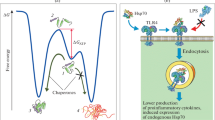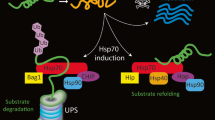Abstract—It is known that chaperones and, in particular, 70 kDa heat shock proteins (HSP70), are an integral part of cellular proteostasis. To assess the role of HSP70 in the neurodegenerative process, we used a new hybrid strain of mice with co-expression of the aberrant ΔFUS protein (1–359) and human HSP70. The mice of the new hybrid line are characterized by a longer lifespan, as well as an increase in the duration of the symptomatic stage as compared to control animals. In addition, according to the results of physiological tests, it can be concluded that HSP70 has a positive effect on muscle strength at the symptomatic stage of the model disease.





Similar content being viewed by others
REFERENCES
Shelkovnikova, T.A., Peters, O.M., Deykin, A.V., Connor-Robson, N., Robinson, H., Ustyugov, A.A., Bachurin, S.O., Ermolkevich, T.G., Goldman, I.L., Sadchikova, E.R., Kovrazhkina, E.A., Skvortsova, V.I., Ling, S.C., Da, CruzS., Parone, P.A., Buchman, V.L., and Ninkina, N.N., J. Biol. Chem., 2013, vol. 288, no. 35, pp. 25266–25274.
Labbadia, J. and Morimoto, R.I., Annu. Rev. Biochem., 2015, no. 84, pp. 435–464.
Yerbury, J.J., Ooi, L., Dillin, A., Saunders, D.N., Hatters, D.M., Beart, P.M., Cashman, N.R., Wilson, M.R., and Ecroyd, H., J. Neurochem., 2016, no. 137, pp. 489–505.
Lackie, R.E., Maciejewski, A., Ostapchenko, V.G., Marques-Lopes, J., Choy, W.-Y., Duennwald, M.L., Prado, V.F., and Prado, M., Front. Neurosci., 2017, vol. 11, pp. 254.
Outeiro, T.F., Putcha, P., Tetzlaff, J.E., Spoelgen, R., Koker, M., Carvalho, F., Hyman, B.T., and McLean, P.J., PLoS One, 2008, no. 3 e1867.
Putcha, P., Danzer, K.M., Kranich, L.R., Scott, A., Silinski, M., Mabbett, S., Hicks, C.D., Veal, J.M., Steed, P.M., Hyman, B.T., and McLean, P.J., J. Pharmacol. Exp. Ther., 2010, no. 332, pp. 849–857.
Sittler, A., Lurz, R., Lueder, G., Priller, J., Hayer-Hartl, M.K., Hartl, F.U., Lehrach, H., and Wanker, E.E., Hum. Mol. Genet., 2001, no. 10, pp. 1307–1315.
Bobkova, N.V., Garbuz, D.G., Nesterova, I., Medvinskaya, N., Samokhin, A., Alexandrova, I., Yashin, V., Karpov, V., Kukharsky, M.S., Ninkina, N.N., Smirnov, A.A., Nudler, E., and Evgen’ev, M.E., J. Alzheimers D., vol. 2, no. 38, pp. 425–435.
Chen, H.-J., Mitchell, J.C., Novoselov, S., Miller, J., Nishimura, A.L., Scotter, E.L., Vance, C.A., Cheetham, M.E., and Shaw, C.E., Brain J. Neurol., 2016, no. 139, pp. 1417–1432.
Gurskiy, Y.G., Garbuz, D.G., Soshnikova, N.V., Krasnov, A.N., Deikin, A., Lazarev, V.F., Sverchinskyi, D., Margulis, B.A., Zatsepina, O.G., Karpov, V.L., Belzhelarskaya, S.N., Feoktistova, E., Georgieva, S.G., and Evgen’ev, M.B., Cell Stress Chaperones, 2016, vol. 21, no. 6, pp. 1055–1064.
Guide for the Care and Use of Laboratory Animals, Eighth Edition, Washington, DC: National Academies Press, 2011.
Funikov, S.Y., Rezvykh, F.P., Mazin, P.V., Morozov, A.V., Maltsev, A.V., Chicheva, M.M., Vikhareva, E.A., Evgen’ev, M.B., and Ustyugov, A.A., Neurogenetics, 2018, vol. 19, no. 3, pp. 189–204.
Funding
The work was supported by the Russian Science Foundation, project no. 19-13-00378 and corresponds to the State Assignment of the Institute of Physiologically Active Substances of the Russian Academy of Sciences 0090-2019-0005 (maintenance and phenotyping of transgenic animals) using the equipment of the Center for Collective Use of the Institute of Physiologically Active Substances of the Russian Academy of Sciences. The mouse strains were created and provided for experiments by the “Genomic Editing” Common Facilities and supported by the Center of high precision editing and genetic technologies for biomedicine of the Institute of Gene Biology of the Russian Academy of Sciences.
Author information
Authors and Affiliations
Corresponding author
Ethics declarations
Conflict of interests. The authors declare that they have no conflicts of interest.
Ethical approval. All manipulations with animals were performed in accordance with the Guide on the maintenance and use of laboratory animals [11]. The protocols of experimental animal research and methods of euthanasia were approved by the Bioethics Commission of Institute of Physiologically Active Substances of the Russian Academy of Sciences (protocol no. 30; April 15, 2019)
Rights and permissions
About this article
Cite this article
Vikhareva, E.A., Chicheva, M.M., Evgen’ev, M.B. et al. Effect of Heat Shock Proteins on Life Span and Behavioral Functions of Animals with FUS Proteinopathy. Neurochem. J. 15, 37–41 (2021). https://doi.org/10.1134/S1819712421010141
Received:
Revised:
Accepted:
Published:
Issue Date:
DOI: https://doi.org/10.1134/S1819712421010141




